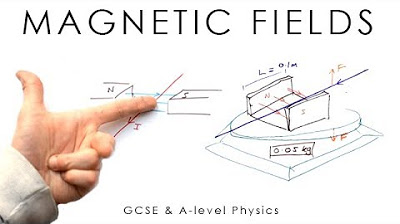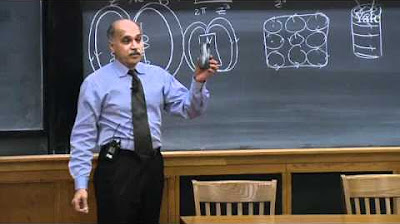GCSE Physics Revision "The Motor Effect"
TLDRThis educational video delves into the motor effect, explaining how a current-carrying wire in a magnetic field experiences a force. It teaches viewers how to calculate this force using the equation F = BIL, where F is the force in Newtons, B is the magnetic flux density in Tesla, I is the current in amperes, and L is the length of the wire in meters. The video also introduces Fleming's left-hand rule to determine the direction of the force, emphasizing that the wire must be perpendicular to the magnetic field to experience a force. A sample problem is provided to illustrate the concept, and the video encourages practice with additional questions in the accompanying workbook.
Takeaways
- 📚 The lesson focuses on explaining the 'motor effect' and how to calculate the force generated by it, which is relevant for high-tier students.
- 🎥🧲 When a current-carrying wire is placed in a magnetic field, it experiences a force due to the interaction between the magnetic fields, resulting in an upward force in the example given.
- 📝 The force acting on the wire can be calculated using the equation: Force (in Newtons) = Magnetic Flux Density (in Tesla) × Current (in Amperes) × Length of the wire (in meters).
- 🔍 This equation specifically applies to a wire that is perpendicular to the magnetic field, and the magnetic flux density measures the strength of the magnetic field.
- 🧠 For the given example, a wire with a length of 2.5 meters carrying a current of 1.5 Amperes in a 0.05 Tesla magnetic field will experience a force of 0.19 Newtons.
- 📈 The size of the force depends on three factors: the magnetic flux density, the current, and the length of the conductor.
- 👉 To determine the direction of the force, Fleming's left-hand rule is used, where the thumb points in the direction of the force, after setting up the hand correctly according to the rule.
- 🔄 If the conductor is parallel to the magnetic field, it will not experience a force, whereas if it is perpendicular, it will.
- 📚 The motor effect is a concept that could be tested in exams, and understanding the factors affecting the force is crucial.
- 📱 Additional resources, such as a workbook, are available for further practice on the motor effect by following the provided link.
Q & A
What is the main topic of the video?
-The main topic of the video is the motor effect, which describes the force experienced by a current-carrying wire placed in a magnetic field.
What is the definition of the motor effect?
-The motor effect is the phenomenon where a wire carrying an electric current experiences a force when placed in a magnetic field, causing it to move.
How can you calculate the size of the force generated by the motor effect?
-The size of the force can be calculated using the equation: Force (in Newtons) = Magnetic flux density (in Tesla) × Current (in amperes) × Length of the wire (in meters).
What are the three factors that affect the size of the force in the motor effect?
-The three factors that affect the size of the force are the magnetic flux density, the current, and the length of the conductor.
How does Fleming's left-hand rule help in determining the direction of the force?
-Fleming's left-hand rule helps to determine the direction of the force by pointing the thumb in the direction of the magnetic field (from north to south), the second finger in the direction of the conventional current (positive to negative), and the thumb then points in the direction of the motion or force.
What happens when a wire is placed parallel to the magnetic field?
-When a wire is placed parallel to the magnetic field, it does not experience a force, meaning there is no motor effect in this orientation.
What is the significance of the wire being at right angles to the magnetic field?
-When the wire is at right angles to the magnetic field, it experiences the maximum force due to the motor effect, as this orientation allows for the greatest interaction between the wire's magnetic field and the external magnetic field.
What is the unit of magnetic flux density and how is it related to the strength of the magnetic field?
-The unit of magnetic flux density is Tesla, and it is a measure of the strength of the magnetic field. Higher Tesla values indicate a stronger magnetic field.
In the sample question, what are the given values and what is the calculated force?
-In the sample question, the given values are a wire length of 2.5 meters, a current of 1.5 amperes, and a magnetic flux density of 0.05 Tesla. The calculated force is 0.195 Newtons.
How does the conventional current direction relate to the actual flow of electrons in a wire?
-The conventional current direction is defined as positive to negative, which is opposite to the actual flow of electrons in a wire. Electrons, being negatively charged, flow from negative to positive.
What is the purpose of the video's mention of the vision workbook?
-The video mentions the vision workbook as a resource for additional practice and questions related to the motor effect, which can be accessed by following the provided link.
Outlines
🔬 Introduction to the Motor Effect
This paragraph introduces the concept of the motor effect, explaining that it involves a wire carrying an electric current experiencing a force when placed in a magnetic field. The force, known as the Ampère's force, is calculated using the equation F = BIL, where F is the force in Newtons, B is the magnetic flux density in Tesla, I is the current in amperes, and L is the length of the wire in meters. The paragraph emphasizes that this formula applies to a wire perpendicular to the magnetic field and that the magnetic flux density measures the strength of the magnetic field. A sample question is provided to demonstrate how to use the formula, and the factors affecting the force's magnitude are discussed.
Mindmap
Keywords
💡Magnetic Field
💡Electric Current
💡Motor Effect
💡Fleming's Left Hand Rule
💡Force
💡Magnetic Flux Density
💡Conductor
💡Newton
💡Ohm Pairs
💡Tesla
💡Right Angles
Highlights
Introduction to the concept of the motor effect in the context of free size lessons, Kol UK.
Explanation of how a magnetic field is produced when a current moves through a wire.
Discussion on the interaction between the magnetic field around a current-carrying wire and an external magnetic field.
Description of the force experienced by a wire in a magnetic field, causing it to move upwards.
The motor effect's relevance to high-tier students and its potential examination points.
Equation for calculating the force experienced by a wire in a magnetic field.
Clarification that the equation applies to a wire perpendicular to the magnetic field.
Explanation of magnetic flux density as a measure of the strength of the magnetic field.
Sample question and calculation of the force acting on a wire with given parameters.
Identification of the three factors affecting the size of the force: magnetic flux density, current, and conductor length.
Demonstration of how to determine the direction of the force using Fleming's left hand rule.
Step-by-step guide on applying Fleming's left hand rule to find the direction of motion.
Explanation that a conductor parallel to the magnetic field will not experience a force.
Emphasis on the importance of understanding the motor effect for high-tier students.
Invitation to access additional resources, such as a workbook, for further study on the motor effect.
Transcripts
Browse More Related Video

Magnetic Force on a Current Carrying Wire

Magnetic Fields, Flux Density & Motor Effect - GCSE & A-level Physics (full version)

Magnetic (AP Physics SuperCram Review)

Magnetism, Magnetic Field Force, Right Hand Rule, Ampere's Law, Torque, Solenoid, Physics Problems

Magnetic Torque | Physics with Professor Matt Anderson | M23-08

9. Magnetism II
5.0 / 5 (0 votes)
Thanks for rating: